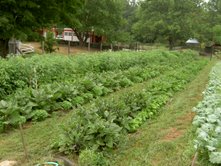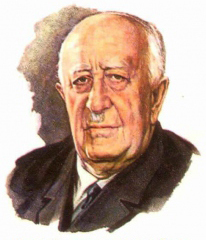
Agricultural science is a broad multidisciplinary field of biology that encompasses the parts of exact, natural, economic and social sciences that are used in the practice and understanding of agriculture. Professionals of the agricultural science are called agricultural scientists or agriculturists.
The following outline is provided as an overview of and topical guide to agriculture:

Soil science is the study of soil as a natural resource on the surface of the Earth including soil formation, classification and mapping; physical, chemical, biological, and fertility properties of soils; and these properties in relation to the use and management of soils.

Agronomy is the science and technology of producing and using plants in agriculture for food, fuel, fiber, recreation, and land restoration. Agronomy has come to encompass work in the areas of plant genetics, plant physiology, meteorology, and soil science. It is the application of a combination of sciences like biology, chemistry, economics, ecology, earth science, and genetics. Professionals in the field of agronomy are called agronomists.
Agroecology (a-grō-ē-ˈkä-lə-jē) is an applied science that studies ecological processes applied to agricultural production systems. Bringing ecological principles to bear can suggest new management approaches in agroecosystems. The term is often used imprecisely, as the term can be used as a science, a movement, or an agricultural practice. Agroecologists study a variety of agroecosystems. The field of agroecology is not associated with any one particular method of farming, whether it be organic, regenerative, integrated, or conventional, intensive or extensive, although some use the name specifically for alternative agriculture.

An agroecosystem is the basic unit of study in agroecology, and is somewhat arbitrarily defined as a spatially and functionally coherent unit of agricultural activity, and includes the living and nonliving components involved in that unit as well as their interactions.

The Polish Academy of Sciences is a Polish state-sponsored institution of higher learning. Headquartered in Warsaw, it is responsible for spearheading the development of science across the country by a society of distinguished scholars and a network of research institutes. It was established in 1951, during the early period of the Polish People's Republic following World War II.
Edaphology is concerned with the influence of soils on living things, particularly plants. It is one of two main divisions of soil science, the other being pedology. Edaphology includes the study of how soil influences humankind's use of land for plant growth as well as people's overall use of the land. General subfields within edaphology are agricultural soil science and environmental soil science.
Soil physics is the study of soil's physical properties and processes. It is applied to management and prediction under natural and managed ecosystems. Soil physics deals with the dynamics of physical soil components and their phases as solid, liquids, and gases. It draws on the principles of physics, physical chemistry, engineering, and meteorology. Soil physics applies these principles to address practical problems of agriculture, ecology, and engineering.

Vladimir Nikolayevich Sukachev was a Russian geobotanist, engineer, geographer, and corresponding member (1920) and full member (1943) of the USSR Academy of Sciences. His wife was Henrietta Ippolitovna Poplavskaja.
Saturnin Zawadzki was a Polish soil scientist. Professor of The Institute for Land Reclamation and Grassland Farming and member of the Institute of Agrophysics, Polish Academy of Sciences (PAN).

The University of Life Sciences in Lublin is a multi-profile higher education institution, which integrates a wide range of agricultural, biological, veterinary, technical and socioeconomic sciences in Poland. Although the university was established in 1955, its history stems back to 1944 with the creation of the Agrarian and Veterinary Faculties within the new Maria Curie-Skłodowska University (UMCS). In 1955, these two faculties, together with the Faculty of Zootechnics, were spun off to create a new institution, originally called the Lublin Higher School of Agriculture. It was called the Lublin Agricultural Academy from 1972, and took its present name in 2008.
Soil microbiology is the study of microorganisms in soil, their functions, and how they affect soil properties. It is believed that between two and four billion years ago, the first ancient bacteria and microorganisms came about on Earth's oceans. These bacteria could fix nitrogen, in time multiplied, and as a result released oxygen into the atmosphere. This led to more advanced microorganisms, which are important because they affect soil structure and fertility. Soil microorganisms can be classified as bacteria, actinomycetes, fungi, algae and protozoa. Each of these groups has characteristics that define them and their functions in soil.
Marcel Florent De Boodt was a professor emeritus of the University of Ghent and has been dean of the Faculty of Agriculture and the Belgian national delegate to the UNESCO Man and the Biosphere Programme.

Regenerative agriculture is a conservation and rehabilitation approach to food and farming systems. It focuses on topsoil regeneration, increasing biodiversity, improving the water cycle, enhancing ecosystem services, supporting biosequestration, increasing resilience to climate change, and strengthening the health and vitality of farm soil.
The Agrophysical Research Institute is a public research and higher education facility dedicated to the study of agrophysics, agricultural sciences and research on physical problems of agriculture. The Institute was founded in 1932 in Leningrad, USSR.
The Bohdan Dobrzański Institute of Agrophysics of the Polish Academy of Sciences is a public research and higher education institution dedicated to the study of agrophysics, agricultural sciences and research on physical problems of agriculture. The Institute publishes two English-language scientific journals, the quarterly Acta Agrophysica and the semi-annual Polish Journal of Soil Science.
Narinder Singh Randhawa (1927–1996) was an Indian agricultural scientist, writer and the director general of the Indian Council of Agricultural Research (ICAR). He was the president of the Indian Society of Soil Science during 1980–81 term and was a recipient of National Citizen Award and Rafi Ahmed Kidwai Award of the Indian Council of Agricultural Research. The Government of India awarded him the third highest civilian honour of the Padma Bhushan, in 1989, for his contributions to agricultural science.
Bohdan Dobrzański was a Polish soil scientist, agrophysicist, agronomist, academic, and professor at several Warsaw- and Lublin-based universities. As the Rector of the Lublin Higher School of Agriculture, he led the formation of the first Chair of Soil Science in Poland. Dobrzański was a pioneer of agrophysics in Poland, a founder and long-time director of the Institute of Agrophysics in Lublin, and the Polish Journal of Soil Science. He is a co-author of the official Table of Land Classes and criteria for valorisation of agricultural production areas. He was awarded a number of prizes and medals including The Commander's Cross of the Order of Polonia Restituta.

Alina Kabata-Pendias was a Polish chemist working in the field of biogeochemistry and soil science. She was a professor of agricultural sciences associated with the Institute of Soil Science and Plant Cultivation in Puławy (IUNG), and the State Geological Institute (PGI). She was a specialist in the field of biogeochemistry of trace elements. Her husband was Henryk Pendias, a geologist and geochemist at PGI. Among other awards, she was the recipient of the Golden Cross of Merit, Order of Polonia Restituta, and the Armia Krajowa Cross.







